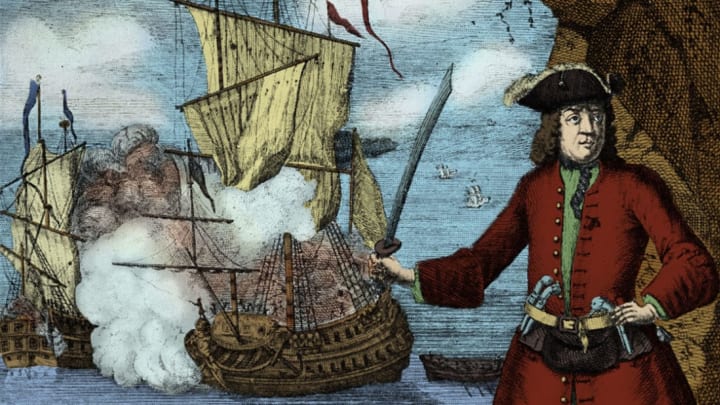Rarely are the greatest crimes successful. Often, perpetrators are either caught or killed, unable to enjoy the spoils of their crime. But during the Golden Age of Piracy (circa 1650-1720), there was one heist so large, by a pirate so audacious, that it triggered a diplomatic crisis. Despite an international manhunt, the mastermind was never brought to justice. This is the story of Henry Every’s raid of the Ganj-i-Sawai.
A New Kind of Pirate
Known at times throughout his life as John Avery, Captain Bridgeman, and Long Ben, Henry Every was born in England around 1653 and quickly took to a life at sea. He spent years serving in the Royal Navy and as an enslaver and privateer. It wasn’t until his late thirties, however, that he began what would become one of the most successful pirate careers in history.
In 1694, Every led a mutiny aboard a privateering vessel, became its captain, and completed his transformation from privateer to pirate. He renamed the ship Fancy and sailed with his crew to the African coasts where the trade routes were full of English, Spanish, and French ships. After months of plundering—and having amassed a small fleet—Every learned of a prize that would change his life.
In 1695, Emperor Aurangzeb Alamgir, ruling what is today India, orchestrated a massive pilgrimage by ship to the holy city of Mecca. The largest and most luxurious of the armada’s 25 vessels, the Ganj-i-Sawai (“Excessive Treasure” in English), was loaded with gold, silver, and precious gems—and protected by hundreds of men as well as dozens of guns on the deck. Though Aurangzeb did not accompany the pilgrimage, hundreds of government officials and their families and entourages were on board.
For Every, this presented a once-in-a-lifetime moment. In August of that same year, he steered his crew toward the Red Sea to intercept the pilgrimage. Knowing a raid of this scale would be no easy task, Every joined with other pirate ships in the area, including the Amity, an American ship captained by another privateer-turned-pirate, Thomas Tew.
The coalition of pirates soon spotted the armada as it headed for the Indian Ocean and began their pursuit. Though much of the pilgrimage escaped that initial contact, Every’s group caught up with the Fateh Mohammed, one of the smaller escort ships, and relieved the vessel of its cargo following a short firefight. This was not enough, however, and Every and his pirates continued their chase. On September 7, they finally approached the Ganj-i-Sawai—their true prize—and opened fire.
A Brutal Attack and Unfathomable Haul

The Fancy’s initial attack was so ferocious that the captain of the Ganj-i-Sawai, Ibrahim Khan, was said to have hidden in his cabin. Without his leadership, the soldiers tasked with defending the vessel quickly succumbed to Every’s assault.
Once they had captured the ship, Every’s crew proceeded to torture and kill their prisoners over several days. So brutal was their treatment of the captives, many prisoners died by suicide before the pirates could put their hands on them.
The haul Every and his men took from the Ganj-i-Sawai was immense. The coins alone were worth upwards of $130 million dollars in today’s money; on top of that, a huge number of precious gems were also looted. In her book Pirates of New England, author Gail Selinger puts the value of the entire cargo at $300 million dollars when adjusted for inflation.
After they had satisfied their bloodlust and divided the spoils, Every and his crew sailed to the Bahamas to lay low and assess the situation.
The Fallout
Across the world, Aurangzeb was furious. He arrested several leading members of the English East India Company under suspicion of conspiring with the pirates and threatened to cancel the Company’s lucrative contracts in the area. Fearing the economic repercussions of such a response, English officials compensated the emperor for the stolen goods and placed an enormous bounty on Every’s head. Soon, the seas were full of Company and Navy ships hunting the elusive pirate across four continents—North America, Europe, Africa, and Asia—making it one of the most massive manhunts of the 17th century.
No one is certain what happened to Henry Every. He and his crew scattered after a short time on the Bahamian island of New Providence. Some reports posit that Every made his way to Ireland or England to live out his days. Isis Davis-Marks, writing for Smithsonian Magazine, relates a theory that Every may have made his way to New England, where coins with Arabic script were found in Rhode Island.
Several of Every’s crew were captured and executed for their crimes (and to maintain a shaky diplomatic peace). But many, including Every, escaped the noose and vanished into history having pulled off one of the most profitable and brutal raids ever.
